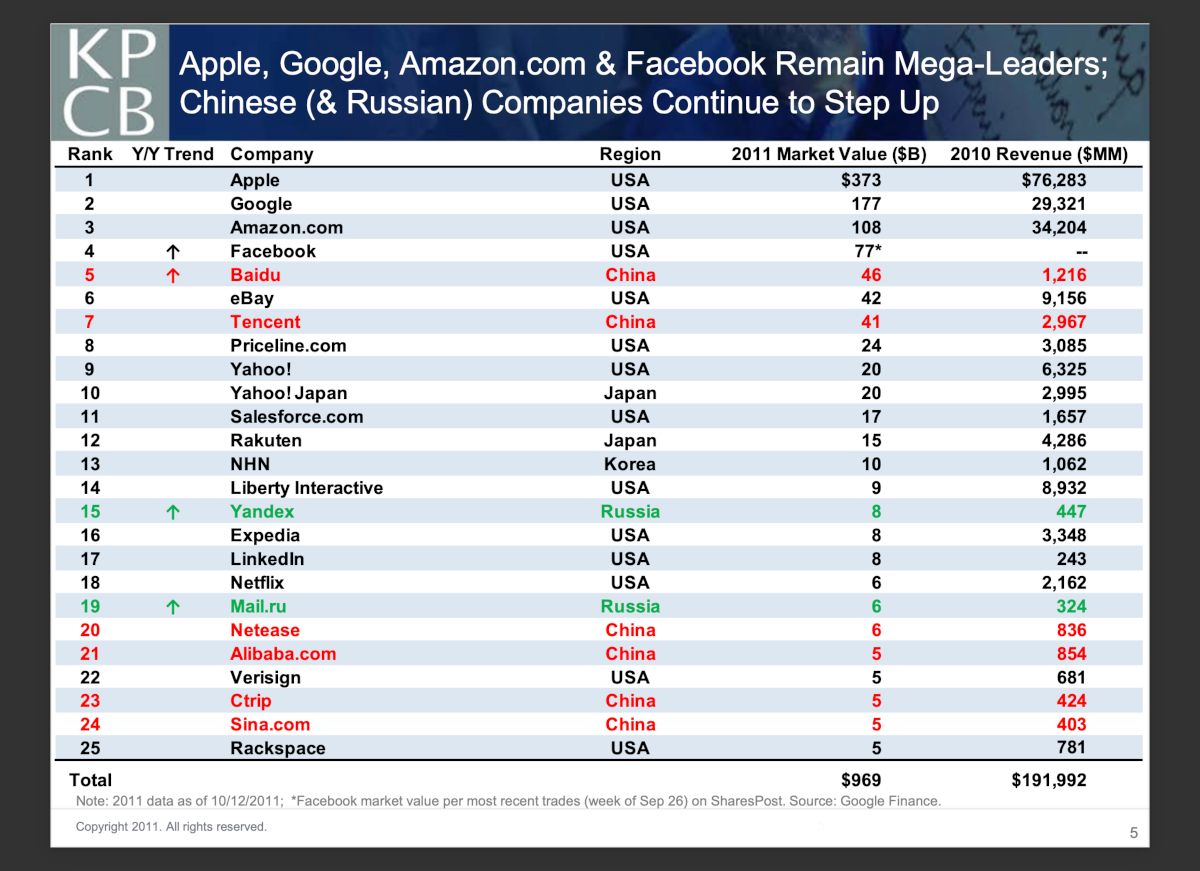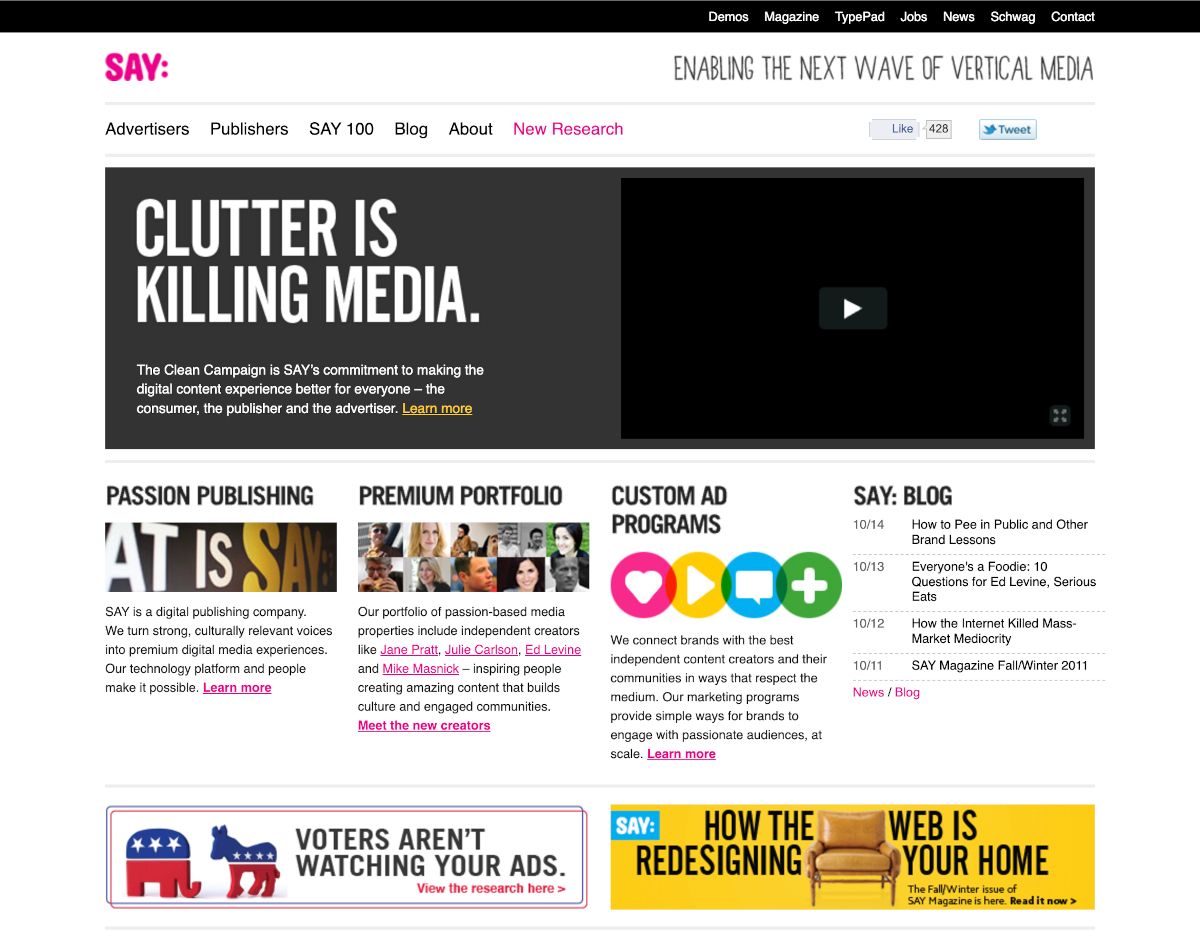The Last Web 2.0 Conference and RWW Acquisition Talks 2.0
In October 2011 in San Francisco, I attend what turns out to be the final Web 2.0 Summit. During the event, my COO Sean and I meet with 5 potential acquirers for ReadWriteWeb.

To prepare for the San Francisco M&A meetings, I’d created a ReadWriteWeb Vision presentation and Sean had created a slide deck about our business growth. Mine was all about our brand and editorial vision, starting with the mission statement for RWW: “Where engaged technologists discover and discuss what’s next on the Web.” I noted that the editorial focused on “smart news and analysis,” which had been our recent pivot after the writer revolt and Marshall stepping back from the editorial leadership. I left the growth goals open-ended, as I figured this would be something we’d discuss individually with each potential acquirer. Our overall goal was “to be the leading analysis site for web tech.”
Sean’s presentation focused heavily on the revenue, and in particular our strong financial year ending March 31, 2011. During that period, the business doubled in revenue while profits increased by almost a factor of five. We were still projecting to increase revenue for the March 2012 year, although it certainly wouldn’t double. We’d also have a decent profit (but again, not five times the profit). So the financials were looking okay, albeit not quite what we’d hoped for.
For editorial statistics, Sean listed the monthly page views at about five million but didn’t elaborate too much—we’d have to talk to the potential acquirers about that in the meetings. Instead, we emphasized our strong brand and community, and audience demographics.

The first meeting was on Monday morning with GigaOm CEO Paul Walborsky. This was the deal we were least optimistic about, since it would probably be stock based with only a little cash (perhaps even none). Sean also didn’t think their stock would be worth much, given the number of funding rounds they’d had.
We met Paul at the GigaOm office on Second Street. I was disappointed to find that Om Malik himself wasn’t in the office that day. Paul suggested I make a time to meet Om separately, so that the two of us could make sure we were aligned editorially. As for the meeting, it’s fair to say that neither side learned much about the other. Paul and Sean danced around the key metrics of our respective businesses, each wary that we were competitors (albeit friendly ones). Paul did confirm, though, that any deal would have to involve stock.
Afterward, Sean and I agreed that it was unlikely anything would happen with GigaOm. I also questioned how serious they were, since Om hadn’t been in the meeting. Still, we hoped they’d at least come to the table with an offer that we could play off against a better (read: mostly cash) deal.

The next meeting was with Laura Baldwin, the president of O’Reilly Media. She’d arranged to meet me at the Pied Piper bar at the Palace Hotel, the venue for the Web 2.0 Summit that would start tomorrow. She and Sean had already met earlier in the month in New York, when he’d briefed her on our business, so it would just be me meeting her today. The idea was for her to get to know me and my editorial vision for the site.
With the conference about to kick off, Laura was very busy, and I got the impression she was distracted by event business. Nonetheless, I thought we had a good chat. I told her I had a great deal of respect for Tim O’Reilly and would relish the chance to work alongside him. I then talked about the ways RWW would complement the O’Reilly Media business—primarily by bringing an active and passionate tech-blog community into their orbit. She said she’d discuss it with Tim and circle back to Sean soon.
Unfortunately, that was the last we heard from O’Reilly Media. Laura went radio silent after this meeting and didn’t respond to follow-ups from Sean or me over the following weeks. For whatever reason, this wasn’t a deal that O’Reilly Media wanted to make. (As far as I know, they have never acquired a blog business to this day.)
The Last Web 2.0 Conference
On Tuesday the Web 2.0 Summit kicked off. Since we had no business meetings scheduled, I figured I’d focus on the event for that day. Jon Mitchell was there, and it was great to spend some time with him. He was a young, bearded guy with dark hair and thin-framed glasses, and so in person he reminded me of Marshall. Although as I got to know him better, I realized he had a creative streak and an interest in the arts—so in that respect, he was probably more similar to me.

One of the highlights of the Web 2.0 Summit every year was the Mary Meeker presentation, in which she did a rapid-fire delivery of a large set of data-heavy slides. This was her first year presenting it on behalf of her new employer, the VC firm Kleiner Perkins Caufield & Byers: she’d moved from Wall Street to Silicon Valley, a reflection of the growing influence of the tech industry in the economy. It didn’t change her bullish outlook for the mobile internet, though. One of the more striking slides was that over half of Twitter’s traffic now came from mobile devices.
What Meeker didn’t cover, at least overtly, was the increasing power of the big-five tech companies. But I was noticing signs that Web 2.0 was becoming less about technology innovation from startups and more about a group of dominant platforms coalescing in the mainstream culture. The big five were increasingly competing with each other, rather than with startups. Amazon had just launched a low-cost tablet, the Kindle Fire, to compete with Apple’s popular iPad. Meanwhile, Apple took on Amazon in cloud computing, with the release of iCloud in October.

The biggest mover, though, was Facebook. In October it released Timeline, a new version of the profile page designed to show highlights from a person’s entire life rather than just recent posts. The goal was clear: to make Facebook much more attractive to “normal people” (the term I used at the time for non-geeks). Alongside the Timeline, Facebook made an even bigger change—although it wasn’t immediately obvious how it would impact society. It began phasing out its chronological News Feed with a new, algorithmic feed that curated what you saw. The company marketed this as “your own personal newspaper,” since the algorithm would theoretically only give you the news you wanted to see. On the flip side, you would no longer get to see updates from everyone you followed.
Back then, nobody thought the algorithmic feed was a big deal. But suddenly, Facebook had great power over what you saw in your feed every day. Web 2.0 was supposed to be about giving users new powers—the power to “write” and not just “read” web content, the power to control your interactions with content through products like RSS readers. It was a subtle change that Facebook made, and the implication only became clear much later: you don’t control what you see in your feed every day, Facebook does.

More M&A Meetings
On Wednesday we had three more meetings with potential acquirers. The first was with FM Publishing CEO Deanna Brown. Since she was so busy that day, it had been scheduled for eight o’clock in the morning at FM’s office, on Townsend Street in South Beach. It was so early, there were hardly any staff there when we arrived—certainly FM’s founder John Battelle was nowhere to be seen (I had to imagine he’d been partying the previous night with Web 2.0 Summit VIPs.) Deanna found a conference room for us to sit in, and we began talking through options.
Sean had warned me that FM didn’t have the money to do a straight acquisition, so they would have to “get creative.” I was skeptical, but since we were heavily reliant on FM for our ongoing revenue, it was at least worth a conversation. What Deanna suggested was a hefty advance in exchange for locking us into an exclusive three-year advertising deal. This offered a couple of advantages: one, I’d be able to pay out my ex-wife with the advance, and two, I’d continue to own RWW. However, the big downside was that it wouldn’t solve any of my company’s structural issues—I still wouldn’t be able to hire US people as employees, for instance.
Afterward, I told Sean that the FM advance deal wasn’t the solution I was looking for. He reminded me that we didn’t currently have another offer on the table, so he advised to keep an open mind.

We also met TechWeb that day—including its CEO, Tony Uphoff, whom I’d gotten to know back in 2008. Tony had some enthusiasm for another bid, but I got a bad feeling when their numbers person began talking about all the steps and processes they’d have to go through with their parent company, UBM, before they’d be able to present an offer. This was what had sunk the deal with TechWeb back in 2008—constant delays with UBM and ultimately an offer that came up well short. I suspected it would be the same story this time round, so I didn’t leave that meeting with much optimism.
As for the company I’d signed a 'letter of intent' with in 2008, ZDE, Sean had not even gotten a response from them over the past month or so (I later heard that ZDE was laden with debt at this time, so acquisitions were probably off the table for them).
The other company we met that day was SAY Media, which I knew little about. Sean had told me it was an online advertising network, like FM Publishing, but that it also offered publishing services. As we walked to the meeting place, at the W Hotel just around the corner from the Web 2.0 Summit, Sean admitted he wasn’t sure I’d like the fit as much as an O’Reilly or TechWeb. He was politely saying, don’t expect too much from this meeting.

We met with two of their corporate development guys, Ken May and Kourosh Karimkhany. To my surprise, I liked the sound of what they were proposing. SAY already had a small portfolio of what they called “passion-based media properties.” Currently these were niche blogs, including Remodelista, xoJane, Food52—none of which I’d heard of before. They had one tech blog, Pocket-lint, a UK gadget blog that I was vaguely familiar with. But they clearly wanted to expand their tech network. Kourosh said they were interested in acquiring RWW to become their flagship tech property.
I was intrigued, so Ken suggested we visit their office the next morning to meet their founder and CEO, Matt Sanchez.

This post is part of my serialized book, Bubble Blog: From Outsider to Insider in Silicon Valley's Web 2.0 Revolution. View table of contents.
Next up: 064. SAY Media Offers To Acquire ReadWriteWeb
Buy the Book
My Web 2.0 memoir, Bubble Blog: From Outsider to Insider in Silicon Valley's Web 2.0 Revolution, is now available to purchase:
- Paperback, US$19.99: Amazon; Bookshop.org
- eBook, US$9.99: Amazon Kindle Store; Apple Books; Google Play
Or search for "Bubble Blog MacManus" on your local online bookstore.